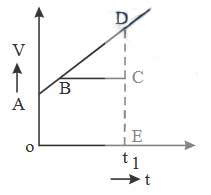31. The distance traveled by a particle is given by
32. A particle is thrown in upward direction with Velocity
33. A particle is thrown in upward direction with initial Velocity
34. Ball A is thrown in upward from the top of a tower of height h. At the same time ball B starts to fall from that point. When A comes to the top of the tower, B reaches the ground. Find the time to reach maximum height for A.
In the figure Velocity (v)
In the figure there is a graph of
A particle is moving in a straight line with intial velocity of 10 m/s. A graph of acceleration
A. 25 m/s
B. 35 m/s
C. 45 m/s
D. 15 m/s
Answer : Option C
Explanation :
Area covered by
A graph of moving body with constant acceleration is given in the figure. What is the velocity after time t ?

The graph given in the figure shows that the body is moving with ?
A. Increasing acceleration
B. Decreasing acceleration
C. Constant velocity
D. Increasing velocity
Answer : Option B
40. Slope of the velocity-time graph gives _________ of a moving body.
